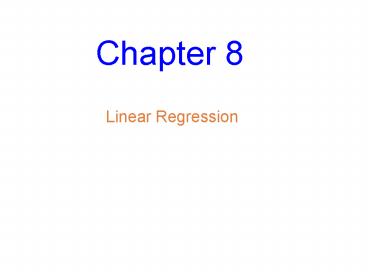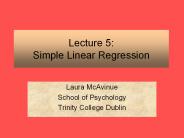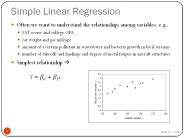Linear Regression - PowerPoint PPT Presentation
1 / 52
Title: Linear Regression
1
Chapter 8
- Linear Regression
2
Fat Versus Protein An Example
- The following is a scatterplot of total fat
versus protein for 30 items on the Burger King
menu
3
Residuals
- The model wont be perfect, regardless of the
line we draw - Some points will be above the line and some will
be below - The estimate made from a model is the
(denoted as )
4
Residuals (cont.)
- The difference between the observed value and its
associated predicted value is called the - To find the residuals, we always subtract the
predicted value from the observed one
5
Residuals (cont.)
- A negative residual means the predicted value is
too big (an overestimate). - A positive residual means the predicted values
too small (an underestimate).
6
Best Fit Means Least Squares
- Some residuals are positive, others are negative,
and, on average, they cancel each other out - Cant assess how well the line fits by adding up
all the residuals - Similar to what we did with deviations, we square
the residuals and add the squares - The smaller the sum, the better the fit
- The is the line for which the sum of the
squared residuals is smallest
7
The Linear Model
- Remember from Algebra that a straight line can be
written as - In Statistics we use a slightly different
notation - We write to emphasize that the points that
satisfy this equation are just our
values, not the actual data values
8
The Linear Model (cont.)
- We write b1 and b0 for the slope and intercept of
the line. The bs are called the of the
linear model. - The coefficient b0 is the , which tells where
the line hits (intercepts) the y-axis. - The coefficient b1 is the , which tells us how
rapidly changes with respect to x.
9
The Least Squares Line
- In our model, we have a slope ( )
- The slope is calculated from the correlation and
the standard deviations - Our slope is always in units of y per unit of x
10
The Least Squares Line (cont.)
- In our model, we also have an intercept ( )
- The intercept is built from the means and the
slope
- Our intercept is always in units of y
11
Fat Versus Protein An Example
- The regression line for the Burger King data fits
the data well - The equation is
- The predicted fat content for a BK Broiler
chicken sandwich (30 g protein) is - 6.8 0.97(30) 35.9
- grams of fat
12
The Least Squares Line (cont.)
- Need to check the following conditions for
regressions - Quantitative Variables Condition
- Straight Enough Condition
13
Correlation and the Line
- Moving one standard deviation away from the mean
in x moves us r standard deviations away from the
mean in y. - This relationship is
shown in a scatterplot
of z-scores for
fat and protein
14
Correlation and the Line (cont.)
- Put generally, moving any number of standard
deviations away from the mean in moves us
times that number of standard deviations away
from the mean in
15
How Big Can Predicted Values Get?
- r cannot be bigger than 1 (in absolute value),
so each predicted y tends to be closer to its
mean (in standard deviations) than its
corresponding x was - This property of the linear model is called
the line is called the
16
Residuals Revisited
- The linear model assumes that the relationship
between the two variables is a perfect straight
line. The residuals are the part of the data that
hasnt been modeled. - or (equivalently)
- Or, in symbols,
17
Residuals Revisited (cont.)
- Residuals help us to see whether the model makes
sense - When a regression model is appropriate, nothing
interesting should be left behind - After we fit a regression model, we usually plot
the residuals in the hope of finding
18
Residuals Revisited (cont.)
- The residuals for the BK menu regression look
appropriately boring
19
R2The Variation Accounted For
- The variation in the residuals is the key to
assessing how well the model fits. - In the BK menu items
example, total fat has
a
standard deviation
of 16.4 grams.
The
standard deviation
of the residuals
is 9.2 grams.
20
R2The Variation Accounted For (cont.)
- If the correlation were 1.0 and the model
predicted the fat values perfectly, the residuals
would all be zero and have no variation - As it is, the correlation is 0.83not perfect
- However, we did see that the model residuals had
less variation than total fat alone - We can determine how much of the variation is
accounted for by the model and how much is left
in the residuals
21
R2The Variation Accounted For (cont.)
- The squared correlation, , gives the fraction
of the datas variance accounted for by the model
- Thus, is the fraction of the original variance
left in the residuals - For the BK model, r2 0.832 0.69, so of
the variability in total fat has been left in the
residuals
22
R2The Variation Accounted For (cont.)
- All regression analyses include this statistic,
although by tradition, it is written
(pronounced R-squared) - An of 0 means that none of the variance in
the data is in the model all of it is still in
the residuals - When interpreting a regression model you need to
Tell what means - In the BK example, according to our linear model,
69 of the variation in total fat is accounted
for by variation in the protein content
23
How Big Should R2 Be?
- is always between 0 and 100
- Qualification for a good value depends on
the kind of data you are analyzing and on what
you want to do with it - The standard deviation of the residuals can give
us more information about the usefulness of the
regression by telling us how much scatter there
is around the line
24
How Big Should R2 Be (cont)?
- Along with the slope and intercept for a
regression, you should always report - Statistics is about variation, and measures
the success of the regression model in terms of
the fraction of the variation of y accounted for
by the regression.
25
Regression Assumptions and Conditions
- Regression can only be done on two quantitative
variables - The linear model assumes that the relationship
between the variables is linear - A scatterplot will let you check that the
assumption is reasonable
26
Regressions Assumptions and Conditions (cont.)
- If the scatterplot is not straight enough, stop
here - You cant use a linear model for any two
variables, even if they are related - They must have a linear association or the model
wont mean a thing - Some nonlinear relationships can be saved by
re-expressing the data to make the scatterplot
more linear
27
Regressions Assumptions and Conditions (cont.)
- Watch out for outliers
- Outlying points can dramatically change a
regression model - Outliers can even change the sign of the slope,
misleading us about the underlying relationship
between the variables
28
Reality Check Is the Regression Reasonable?
- Statistics dont come out of nowhere. They are
based on data - The results of a statistical analysis should
reinforce your common sense - If the results are surprising, then either youve
learned something new about the world or your
analysis is wrong - When you perform a regression, think about the
coefficients and ask yourself whether they make
sense
29
What Can Go Wrong?
- Dont fit a straight line to a nonlinear
relationship - Beware of extraordinary points
- Dont invert the regression. To swap the
predictor-response roles of the variables, we
must fit a new regression equation - Dont extrapolate beyond the data
- Dont infer that x causes y just because there is
a good linear model for their relationship - Dont choose a model based on R2 alone
30
What have we learned?
- When the relationship between two quantitative
variables is fairly straight, a linear model can
help summarize that relationship - The regression line doesnt pass through all the
points, but it is the best compromise in the
sense that it has the smallest sum of squared
residuals
31
What have we learned? (cont.)
- The correlation tells us several things about the
regression - The slope of the line is based on the
correlation, adjusted for the units of x and y. - For each SD in x that we are away from the x
mean, we expect to be r SDs in y away from the y
mean. - Since r is always between -1 and 1, each
predicted y is fewer SDs away from its mean than
the corresponding x was (regression to the mean). - R2 gives us the fraction of the variation of the
response accounted for by the regression model.
32
What have we learned? (cont.)
- The residuals also reveal how well the model
works - If a plot of the residuals against predicted
values shows a pattern, we should re-examine the
data to see why - The standard deviation of the residuals
quantifies the amount of scatter around the line
33
What have we learned? (cont.)
- The linear model makes no sense unless the Linear
Relationship Assumption is satisfied - Also, we need to check the Straight Enough
Condition and Outlier Condition - For the standard deviation of the residuals, we
must make the Equal Variance Assumption. We
check it by looking at both the original
scatterplot and the residual plot for Does the
Plot Thicken? Condition
34
Practice Exercise
- Fast food is often considered unhealthy because
much of it is high in both fat and calories. But
are the two related? Here are the fat contents
and calories of several brands of burgers
Fat (g) 19 31 34 35 39 39 43
Calories 410 580 590 570 640 680 660
35
Practice Exercise
36
Practice Exercise
37
Practice Exercise
38
Practice Exercise
39
Practice Exercise
40
Practice Exercise
41
Practice Exercise
42
Practice Exercise
- How can we fit a regression line with excel?
A B
1 Fat (g) Calories
2 19 410
3 31 580
4 34 590
5 35 570
6 39 640
7 39 680
8 43 660
43
Practice Exercise
- Pull down menus
- Tools/data analysis/regression/ok
44
Practice Exercise
45
SUMMARY OUTPUT
Regression Statistics Regression Statistics
Multiple R 0.960632851
R Square 0.922815474
Adjusted R Square 0.907378569
Standard Error 27.33397534
Observations 7
ANOVA
df SS MS F Significance F
Regression 1 44664.26896 44664.26896 59.77982419 0.000578186
Residual 5 3735.73104 747.146208
Total 6 48400
Coefficients Standard Error t Stat P-value Lower 95 Upper 95 Lower 95.0 Upper 95.0
Intercept 210.9538702 50.10143937 4.210535124 0.008403906 82.16402029 339.7437201 82.16402029 339.7437201
Fat (g) 11.05551212 1.429886442 7.731741343 0.000578186 7.379872006 14.73115223 7.379872006 14.73115223
RESIDUAL OUTPUT PROBABILITY OUTPUT
Observation Predicted Calories Residuals Percentile Calories
1 421.0086005 -11.00860047 7.142857143 410
2 553.6747459 26.3252541 21.42857143 570
3 586.8412823 3.158717748 35.71428571 580
4 597.8967944 -27.89679437 50 590
5 642.1188428 -2.118842846 64.28571429 640
6 642.1188428 37.88115715 78.57142857 660
7 686.3408913 -26.34089132 92.85714286 680
46
SUMMARY OUTPUT
Regression Statistics Regression Statistics
Multiple R 0.960632851
R Square 0.922815474
Adjusted R Square 0.907378569
Standard Error 27.33397534
Observations 7
47
ANOVA
df SS MS F Significance F
Regression 1 44664.2689 44664.2696 59.77982419 0.000578186
Residual 5 3735.73104 747.146208
Total 6 48400
Coefficients Standard Error t Stat P-value Lower 95 Upper 95 Lower 95.0 Upper 95.0
Intercept 210.9538702 50.10143937 4.210535124 0.008403906 82.16402029 339.7437201 82.16402029 339.7437201
Fat (g) 11.05551212 1.429886442 7.731741343 0.000578186 7.379872006 14.73115223 7.379872006 14.73115223
48
Practice Exercise
49
RESIDUAL OUTPUT
Observation Predicted Calories Residuals
1 421.0086005 -11.00860047
2 553.6747459 26.3252541
3 586.8412823 3.158717748
4 597.8967944 -27.89679437
5 642.1188428 -2.118842846
6 642.1188428 37.88115715
7 686.3408913 -26.34089132
50
Practice Exercise
51
PROBABILITY OUTPUT
Percentile Calories
7.142857143 410
21.42857143 570
35.71428571 580
50 590
64.28571429 640
78.57142857 660
92.85714286 680
52
Practice Exercise































